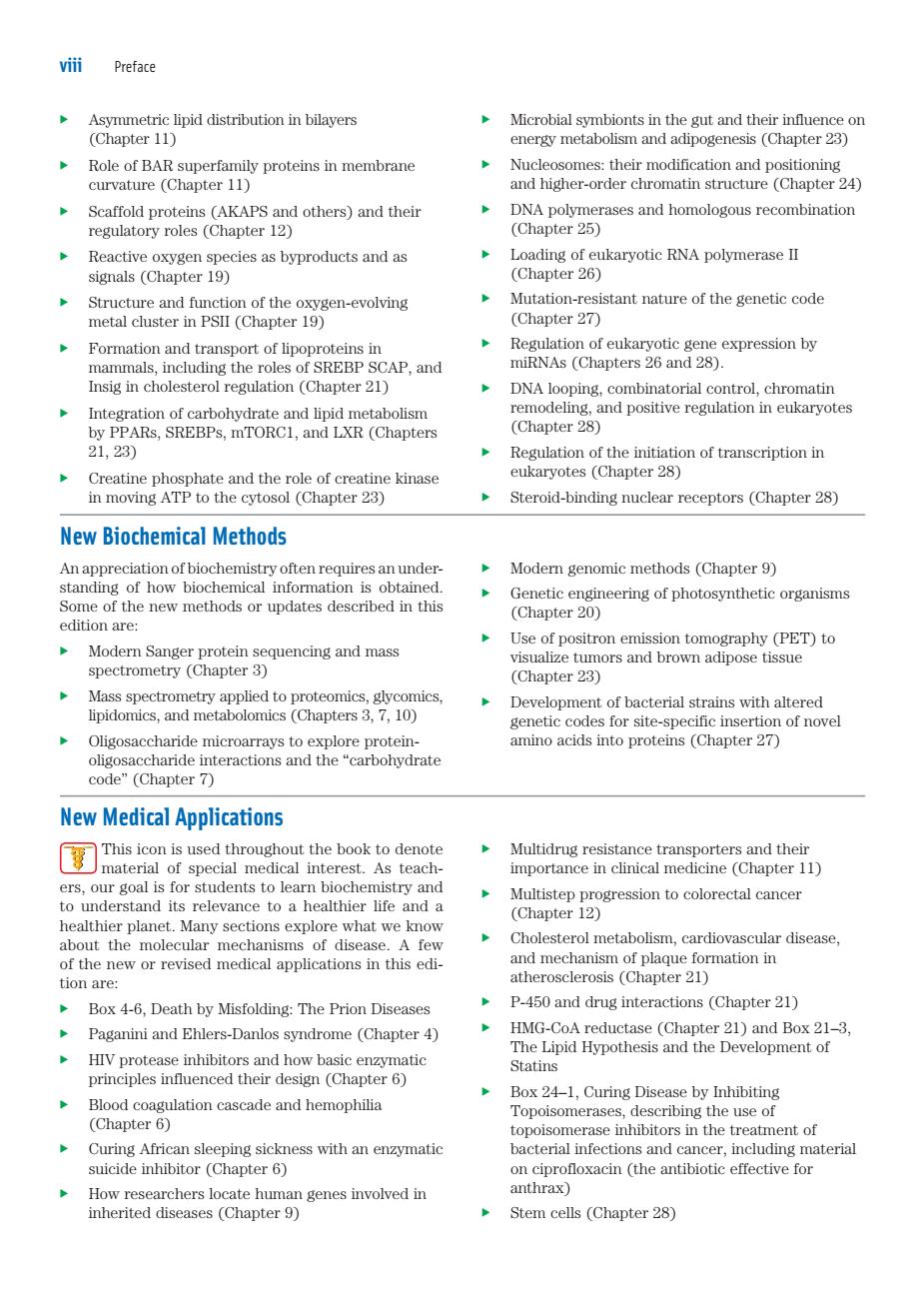正在加载图片...

Preface 合petipddtihutiomntyeas 4 24 Scaffold proteins (AKAPS and others)and their 4 regulatory roles (Chapter 12) ane25esandonoaognsreconmbnatioa Reactive oxygen species as byproducts and as signals (Chapter 19) apgrgnotcRApotnense 4 Structure and function of the oxvgen-evolving Mutation-resistant nature of the genetic code metal cluster in PSII(Chapter 19) (Chapter 27) 4 Insig in cholesterol regulation (Chapter 21) DNA looping,combinatorial control,chromatin 4 S)p Integration of carbohydrate and lipid metabolism Creatine phosphate and the role of creatine kinase in moving ATP to the cytosol (Chapter 23) Steroid-binding nuclear receptors (Chapter 28) New Biochemical Methods An appreciation of biochemistry often requires an under Moder genomic methods (Chapter 9) edition are y (PET)to (Chapter 23) Development of bacterial strains with altered genetic codes for site-specific insertion of novel amino acids into proteins (Chapter 27) rate code"(Chanter 7 New Medical Applications 国 rters and their 么indea or amdent to learn boer Ne sion to colorectal cance th and about the molecular mechanisms of disease ular disease atherosclerosis (Chapter 21) Box 4-6,Death by Misfolding:The Prion Diseases P-450 and drug interactions (Chapter 21) Paganini and Ehlers-Danlos syndrome (Chapter 4) 4 HIV prote nd ho Statins by Inhibitin agulation cascade and hemophilia Chapter6 4 eatment of ess with an enzymati terial suicide inhibitor (Chapter 6) on c profloxacin(the antibiotic effective for anthrax) Stem cells (Chapter 28) viii Preface u Asymmetric lipid distribution in bilayers (Chapter 11) u Role of BAR superfamily proteins in membrane curvature (Chapter 11) u Scaffold proteins (AKAPS and others) and their regulatory roles (Chapter 12) u Reactive oxygen species as byproducts and as signals (Chapter 19) u Structure and function of the oxygen-evolving metal cluster in PSII (Chapter 19) u Formation and transport of lipoproteins in mammals, including the roles of SREBP SCAP, and Insig in cholesterol regulation (Chapter 21) u Integration of carbohydrate and lipid metabolism by PPARs, SREBPs, mTORC1, and LXR (Chapters 21, 23) u Creatine phosphate and the role of creatine kinase in moving ATP to the cytosol (Chapter 23) u Microbial symbionts in the gut and their influence on energy metabolism and adipogenesis (Chapter 23) u Nucleosomes: their modification and positioning and higher-order chromatin structure (Chapter 24) u DNA polymerases and homologous recombination (Chapter 25) u Loading of eukaryotic RNA polymerase II (Chapter 26) u Mutation-resistant nature of the genetic code (Chapter 27) u Regulation of eukaryotic gene expression by miRNAs (Chapters 26 and 28). u DNA looping, combinatorial control, chromatin remodeling, and positive regulation in eukaryotes (Chapter 28) u Regulation of the initiation of transcription in eukaryotes (Chapter 28) u Steroid-binding nuclear receptors (Chapter 28) New Biochemical Methods An appreciation of biochemistry often requires an understanding of how biochemical information is obtained. Some of the new methods or updates described in this edition are: u Modern Sanger protein sequencing and mass spectrometry (Chapter 3) u Mass spectrometry applied to proteomics, glycomics, lipidomics, and metabolomics (Chapters 3, 7, 10) u Oligosaccharide microarrays to explore proteinoligosaccharide interactions and the “carbohydrate code” (Chapter 7) u Modern genomic methods (Chapter 9) u Genetic engineering of photosynthetic organisms (Chapter 20) u Use of positron emission tomography (PET) to visualize tumors and brown adipose tissue (Chapter 23) u Development of bacterial strains with altered genetic codes for site-specific insertion of novel amino acids into proteins (Chapter 27) New Medical Applications This icon is used throughout the book to denote material of special medical interest. As teachers, our goal is for students to learn biochemistry and to understand its relevance to a healthier life and a healthier planet. Many sections explore what we know about the molecular mechanisms of disease. A few of the new or revised medical applications in this edition are: u Box 4-6, Death by Misfolding: The Prion Diseases u Paganini and Ehlers-Danlos syndrome (Chapter 4) u HIV protease inhibitors and how basic enzymatic principles influenced their design (Chapter 6) u Blood coagulation cascade and hemophilia (Chapter 6) u Curing African sleeping sickness with an enzymatic suicide inhibitor (Chapter 6) u How researchers locate human genes involved in inherited diseases (Chapter 9) u Multidrug resistance transporters and their importance in clinical medicine (Chapter 11) u Multistep progression to colorectal cancer (Chapter 12) u Cholesterol metabolism, cardiovascular disease, and mechanism of plaque formation in atherosclerosis (Chapter 21) u P-450 and drug interactions (Chapter 21) u HMG-CoA reductase (Chapter 21) and Box 21–3, The Lipid Hypothesis and the Development of Statins u Box 24–1, Curing Disease by Inhibiting Topoisomerases, describing the use of topoisomerase inhibitors in the treatment of bacterial infections and cancer, including material on ciprofloxacin (the antibiotic effective for anthrax) u Stem cells (Chapter 28) FMTOC.indd Page viii 09/10/12 1:57 PM user-F408 /Users/user-F408/Desktop